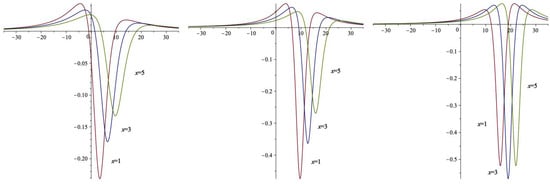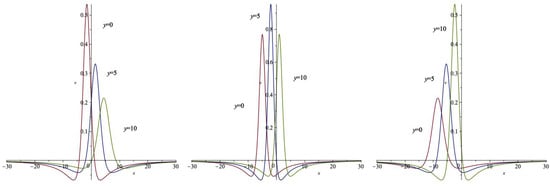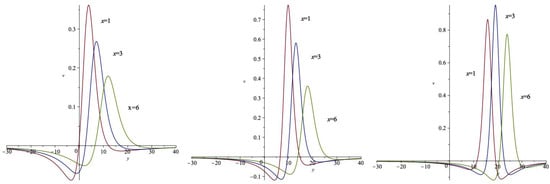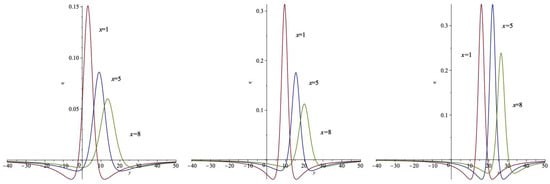Abstract
This study investigates lump wave structures that arise from the interplay of dispersion and nonlinearity in a generalized Calogero–Bogoyavlenskii–Schiff-like model with spatially symmetric nonlinearity in (2+1) dimensions. A generalized bilinear representation of the governing equation is formulated using extended bilinear derivatives of the fourth order, providing a convenient framework for analytic treatment. Through symbolic computation, we construct positive quadratic wave solutions, which give rise to rationally localized lump wave tructures that decay algebraically in all spatial directions at fixed time. Analysis shows that the critical points of these quadratic waves lie along a straight line in the spatial plane and propagate at a constant velocity. Along this characteristic trajectory, the amplitudes of the lump waves remain essentially unchanged, reflecting the stability of these coherent structures. The emergence of these lumps is primarily driven by the combined influence of five dispersive terms in the model, highlighting the crucial role of higher-order dispersion in balancing the nonlinear interactions and shaping the resulting localized waveforms.
MSC:
35Q51; 35Q53; 37K40
1. Introduction
In soliton theory and the study of integrable models, solitons and lump waves receive a great deal of attention. These nonlinear wave phenomena are characterized by distinct dynamical features: solitons are stable, exponentially localized waves, while lump waves are rationally localized structures that decay to zero in all spatial directions. Such dispersive patterns arise from a delicate balance between nonlinearity and dispersion, and their analytical or numerical construction continues to play a central role in the study of nonlinear dispersive wave dynamics.
Hirota’s bilinear method [] and the inverse scattering transform (IST) [,] are two cornerstone techniques for constructing the exact solutions described above. Hirota’s method provides a direct algebraic approach for systematically generating multi-soliton and rational solutions, especially in higher-dimensional systems [,,,,,]. In contrast, the IST offers a spectral framework for solving integrable PDEs through their associated Lax pairs of matrix spectral problems [], enabling the analysis of soliton dynamics and the long-time behavior of dispersive waves [].
Let P be a polynomal in M variables. In general, a Hirota bilinear equation can be written as
where denotes Hirota’s bilinear operator [], defined by
with , , , and . Within the bilinear framework, N-soliton solutions can be expressed as exponential superpositions (see, e.g., []):
where the summation runs over all . The linear phases and the phase shifts are given by
with the dispersion relations
Let f be defined by (3) and denote with that is omitted. Thus, one can obtain a recursive relation for computing the bilinear expression:
where
with each in belonging to .
Based on the recursive relation (6), a Hirota bilinear equation admits an N-soliton solution if and only if all Hirota conditions are satisfied:
for and , where with . The case recovers the dispersion relations in (5).
For the (2+1)-dimensional case, let denote spatial variables and t time. A general Hirota bilinear equation in (2+1) dimensions can be expressed as
where P is a polynomial in the three variables. Using Bell polynomial theory, nonlinear PDEs for a scalar field u can be derived from such bilinear forms via logarithmic derivative transformations. Typical transformations include
where is a constant. A crucial step is to verify that f satisfies the bilinear equation and that the corresponding field u, defined through one of these logarithmic transformations, satisfies the associated nonlinear PDE. Systematic algorithms for performing this verification have been established for both (1+1)- and (2+1)-dimensional cases.
Another important class of explicit structures includes rogue waves and lump waves. Rogue waves are transient, large-amplitude localized structures that decay in all directions in both space and time. Lump waves, by contrast, are rationally localized, decaying algebraically in all spatial directions at fixed time []. For example, the KPI equation admits a variety of lump solutions, some of which arise as long-wave limits of multi-soliton configurations [,]. Lump-type solutions have also been observed in nonintegrable KP-, BKP-, and KP-Boussinesq-type systems (see, e.g., [,,,]) and even in linear higher-dimensional wave models through superposition principles.
The sum-of-squares ansatz, which inserts a positive quadratic function into a bilinear equation, has proven effective for constructing lump solutions []. When combined with logarithmic derivative transformations, this approach yields explicit lump solutions for a wide class of nonlinear PDEs.
In this work, we employ the sum-of-squares ansatz for a (2+1)-dimensional generalized Calogero–Bogoyavlenskii–Schiff-like (gCBS-like) model with spatially symmetric nonlinearity and five dispersion terms. The resulting lump wave structures emerge from the delicate interplay of these dispersive effects. Using symbolic computation, we derive explicit lump solutions and analyze the critical points of the associated quadratic forms, providing detailed insight into the wave dynamics. Examples with both 2D and 3D plots of the resulting lump waves are also presented.
2. A gCBS-like Model with Spatially Symmetric Nonlinearity
We employ generalized bilinear derivatives to formulate a gCBS-like model equation. A broad class of generalized bilinear differential operators was introduced in []. In the (2+1)-dimensional case with coordinates , they are defined as
where the coefficients are given by
For example, for , the sequence of coefficients is
and for , it is
The coefficients for other values of p can be computed in a similar manner (see []). In summary, the sign sequences for are
Investigating the characteristic properties of these alternating sign sequences is an interesting endeavor.
2.1. Bilinear Form with Generalized Derivatives
For , we propose the following gCBS-like model equation:
where , and are the generalized bilinear derivatives, and for denote arbitrary constants.
The fourth-order derivatives and appear in a partially symmetric form, generating the nonlinear terms in the corresponding nonlinear model. In contrast, the Bogoyavlensky–Konopelchenko-like equation, where the second fourth-order term is (see, e.g., ref. [] for the case), leads to a different structure. Meanwhile, in the KP-like model, the nonlinearity involves only the fourth-order term , without the mixed term .
This construction for produces a novel model capable of supporting lump wave solutions. We refer to this as a generalized model since it contains all second-order linear dispersion terms, whereas the original model only involves a single second-order term , which produces the linear dispersion.
2.2. Nonlinear Formulation
By redefining the dependent variables as
the gCBS-like model in its nonlinear form reads as follows:
where the nonlinear terms are given by
provided the compatibility conditions hold:
This equation incorporates a set of spatially symmetric nonlinear terms and five dispersive contributions. Despite its complexity, it admits lump wave solutions induced by the interplay of the dispersive terms.
Special reductions occur when only one pair of dispersion coefficients is nonzero. For example, if , , and the others vanish, the model Equation (21) reduces to
If , , and the others vanish, the model reduces to
In both cases, the compatibilty conditions (23) remain enforced. These reduced models still admit lump wave structures, regardless of the positive or negative signs in front of the dispersion terms and .
2.3. Correspondence Between Bilinear and Nonlinear Forms
The bilinear form (19) and the nonlinear Equation (21) are related through
under the transformations in (20). Consequently, any solution f of the bilinear equation determines corresponding fields , that satisfy the nonlinear model.
It can be readily verified that this model does not support a general class of N-soliton solutions. A natural question then arises: does it admit lump wave structures, which are often characteristic of integrable systems? In the following, we investigate lump wave solutions generated by the interplay of the five dispersive terms in the model.
3. Formation of Lump Waves via Dispersion
We now focus on the explicit construction of lump wave solutions for the nonlinear model (21) by employing its generalized bilinear form (19) together with symbolic computation. Particular attention is given to the interplay of the five dispersive terms, which jointly give rise to the lump wave structures. Moreover, we examine the critical points of the corresponding quadratic function to gain insight into the localization and dynamical behavior of the resulting lump waves.
3.1. Sum-of-Squares Ansatz Approach
The sum-of-squares ansatz has become a standard approach for constructing lump solutions in higher-dimensional nonlinear evolution equations []. Its key idea is to express the dependent variable as logarithmic derivatives of a positive quadratic function f. In particular, we take
which can produce rational localization in all spatial directions in the -plane. Substituting (27) into the generalized bilinear Equation (19) reduces the problem to an algebraic system for the parameters .
Symbolic computation provides explicit expressions for , , and in terms of the other coefficients:
and
These expressions encode the dispersion relations and structural constraints for the lump waves. In particular, and determine the temporal frequencies associated with higher-order rational combinations of dispersion coefficients, while reflects a balance between the wave numbers and the dispersion parameters. Similar dispersion expressions appear in lump wave solutions of the second flow of the KP hierarchy and in generalized KP-type models (see, e.g., refs. [,,]).
Well-posedness and spatial localization require two essential non-degeneracy conditions. First, the dispersion condition
ensures
and, second, the determinant condition
guarantees
ensuring that the solutions defined through the logarithmic derivative transformations in (20), decay to zero as , confirming spatial localization.
The positivity of f, and, hence, the analyticity of the resulting lump waves , is ensured by the mixed necessary and sufficient condition involving the dispersion parameters and the wave numbers:
This requirement can be satisfied in either of the following two cases:
with
or
with
To satisfy the sufficient condition in (36), one may, for instance, choose
Similarly, to satisfy the sufficient condition in (38), one may assume
The dispersion coefficient contributes only when both and are nonzero.
Condition (35) guarantees in (30), keeping f strictly positive and thus ensuring the analyticity of across the entire -domain. The conditions in (36) and (38) essentially act as two dispersion-parameter constraints, emphasizing that the formation of lump waves stems from the linear dispersive terms. Interestingly, in either case, and and and , the other dispersion coefficient or could be positive or negative, generating lump wave solutions.
In summary, the construction of lump wave solutions via the logarithmic derivative transformations requires two essential conditions: the determinant condition (33), which secures spatial localization, and the positivity condition (35), which guarantees the well-posedness of and s across the spatial–temporal domain. The sufficient conditions (36) and (37) or (38) and (39) further establish the existence of lump waves. Under these constraints, the resulting indeed constitute valid lump wave solutions.
3.2. Trajectory of Critical Points
The dynamical behaviour of the lump waves can be further elucidated by analyzing the critical points of f. Setting leads to
which, under the non-degeneracy condition (33), reduces to
with as defined in (27). Solving this system gives explicit linear trajectories and , representing critical points of the quadratic function f:
These expressions describe straight-line trajectories in the -plane, along which the lump waves remain stationary, while the solutions stay rationally localized in the surrounding region.
The Figure 1, Figure 2, Figure 3, Figure 4, Figure 5, Figure 6, Figure 7, Figure 8 and Figure 9 below provide 3D and 2D plots of the lump waves , , and , computed for the parameter sets specified as follows:
and

Figure 1.
Three-dimensional plots of u with (left), (middle), and (right).

Figure 2.
x curves of u with (left), (middle), and (right).

Figure 3.
y curves of u with (left), (middle), and (right).

Figure 4.
Three-dimensional plots of v with (left), (middle), and (right).

Figure 5.
x curves of v with (left), (middle), and (right).

Figure 6.
y curves of v with (left), (middle), and (right).

Figure 7.
Three-dimensional plots of w with (left), (middle), and (right).

Figure 8.
x curves of w with (left), (middle), and (right).

Figure 9.
y curves of w with (left), (middle), and (right).
4. Concluding Remarks
We formulated and analyzed a novel (2+1)-dimensional gCBS-like model with spatially symmetric nonlinearity and constructed its lump wave solutions using symbolic computation in computer algebra systems. These lump waves remain invariant along characteristic trajectories determined by the critical points of the corresponding quadratic function, illustrating the subtle interplay among the dispersive terms.
Lump waves arise in a wide range of physical and mathematical contexts, demonstrating both their versatility and the challenges associated with modeling nonlinear dispersive phenomena. They appear in linear models as well as in nonlinear and nonintegrable systems in (2+1) dimensions [,,,,], (3+1) dimensions [,], and (4+1) dimensions []. Their explicit construction often relies on Hirota bilinear forms [] and generalized bilinear techniques [], providing a systematic framework for identifying spatially localized coherent structures.
Moreover, lump waves exhibit rich interactions with other coherent structures in (2+1)-dimensional integrable systems, including homoclinic and heteroclinic waves [,,]. They can also be derived as long-wave or wave-number reductions from N-soliton solutions. At the same time, N-soliton solutions and integrability properties have been extensively studied in both local and nonlocal settings, for instance, via Riemann–Hilbert methods, bi-Hamiltonian formulations, and group reductions [,,,,]. The existence, algebro-geometric structure, and dynamics of lump waves in (2+1)-dimensional extensions of integrable systems—whether scalar or multi-component, standard or generalized—remain active and compelling areas of research [,,,,].
In summary, the study of lump waves deepens insight into nonlinear dispersive wave dynamics and may inform applications in physical and engineering contexts, where localized, coherent, energy-concentrated structures are important.
Funding
This work was supported in part by the National Natural Science Foundation of China (12271488 and 11975145) and the Ministry of Science and Technology of China (G2021016032L and G2023016011L).
Data Availability Statement
No data were used for the research described in the article.
Conflicts of Interest
The author declares that there are no known competing financial interests or personal relationships that could have appeared to influence the work reported in this paper.
References
- Hirota, R. The Direct Method in Soliton Theory; Cambridge University Press: New York, NY, USA, 2004. [Google Scholar] [CrossRef]
- Ablowitz, M.J.; Segur, H. Solitons and the Inverse Scattering Transform; SIAM: Philadelphia, PA, USA, 1981. [Google Scholar] [CrossRef]
- Novikov, S.; Manakov, S.V.; Pitaevskii, L.P.; Zakharov, V.E. Theory of Solitons—The Inverse Scattering Method; Consultants Bureau: New York, NY, USA, 1984. [Google Scholar]
- Hirota, R. Exact solution of the Korteweg-de Vries equation for multiple collisions of solitons. Phys. Rev. Lett. 1971, 27, 1192–1194. [Google Scholar] [CrossRef]
- Caudrey, P.J. Memories of Hirota’s method: Application to the reduced Maxwell-Bloch system in the early 1970s. Philos. Trans. R. Soc. A 2011, 369, 1215–1227. [Google Scholar] [CrossRef] [PubMed]
- Ma, W.X. Lump solutions to the Kadomtsev-Petviashvili equation. Phys. Lett. A 2015, 379, 1975–1978. [Google Scholar] [CrossRef]
- Liu, J.G.; Zhou, L.; He, Y. Multiple soliton solutions for the new (2+1)-dimensional Korteweg-de Vries equation by multiple exp-function method. Appl. Math. Lett. 2018, 80, 71–78. [Google Scholar] [CrossRef]
- Manafian, J. Novel solitary wave solutions for the (3+1)-dimensional extended Jimbo-Miwa equations. Comput. Math. Appl. 2018, 76, 1246–1260. [Google Scholar] [CrossRef]
- Chu, J.Y.; Liu, Y.Q.; Ma, W.X. Integrability and multiple-rogue and multi-soliton wave solutions of the (3+1)-dimensional Hirota–Satsuma–Ito equation. Mod. Phys. Lett. B 2025, 39, 2550060. [Google Scholar] [CrossRef]
- Zakharov, V.E.; Shabat, A.B. A scheme for integrating the nonlinear equations of mathematical physics by the method of the inverse scattering problem I. Funct. Anal. Appl. 1974, 8, 226–235. [Google Scholar] [CrossRef]
- Ablowitz, M.J.; Newell, A.C. The decay of the continuous spectrum for solutions of the Korteweg-de Vries equation. J. Math. Phys. 1973, 14, 1277–1284. [Google Scholar] [CrossRef]
- Tan, W.; Dai, H.P.; Dai, Z.D.; Zhong, W.Y. Emergence and space-time structure of lump solution to the (2+1)-dimensional generalized KP equation. Pramana 2017, 89, 77. [Google Scholar] [CrossRef]
- Manakov, S.V.; Zakharov, V.E.; Bordag, L.A.; Matveev, V.B. Two-dimensional solitons of the Kadomtsev-Petviashvili equation and their interaction. Phys. Lett. A 1977, 63, 205–206. [Google Scholar] [CrossRef]
- Satsuma, J.; Ablowitz, M.J. Two-dimensional lumps in nonlinear dispersive systems. J. Math. Phys. 1979, 20, 1496–1503. [Google Scholar] [CrossRef]
- Kaup, D.J. The lump solutions and the Bäcklund transformation for the three-dimensional three-wave resonant interaction. J. Math. Phys. 1981, 22, 1176–1181. [Google Scholar] [CrossRef]
- Gilson, C.R.; Nimmo, J.J.C. Lump solutions of the BKP equation. Phys. Lett. A 1990, 147, 472–476. [Google Scholar] [CrossRef]
- Imai, K. Dromion and lump solutions of the Ishimori-I equation. Prog. Theor. Phys. 1997, 98, 1013–1023. [Google Scholar] [CrossRef]
- Ma, W.X. Generalized bilinear differential equations. Stud. Nonlinear Sci. 2011, 2, 140–144. [Google Scholar]
- Chen, S.T.; Ma, W.X. Lump solutions to a generalized Bogoyavlensky-Konopelchenko equation. Front. Math. China 2018, 13, 525–534. [Google Scholar] [CrossRef]
- Sun, Y.; Tian, B.; Xie, X.Y.; Chai, J.; Yin, H.M. Rogue waves and lump solitons for a (3+1)-dimensional B-type Kadomtsev-Petviashvili equation in fluid dynamics. Waves Random Complex Media 2018, 28, 544–552. [Google Scholar] [CrossRef]
- Ma, W.X. Lump waves and their dynamics of a spatial symmetric generalized KP model. Rom. Rep. Phys. 2024, 76, 108. [Google Scholar] [CrossRef]
- Liu, M.M.; Yu, J.P.; Ma, W.X.; Khalique, C.M.; Sun, Y.L. Dynamic analysis of lump solutions based on the dimensionally reduced generalized Hirota bilinear KP-Boussinesq equation. Mod. Phys. Lett. B 2023, 37, 2250203. [Google Scholar] [CrossRef]
- Manukure, S.; Zhou, Y.; Ma, W.X. Lump solutions to a (2+1)-dimensional extended KP equation. Comput. Math. Appl. 2018, 75, 2414–2419. [Google Scholar] [CrossRef]
- Wang, H. lump and interaction solutions to the (2+1)-dimensional Burgers equation. Appl. Math. Lett. 2018, 85, 27–34. [Google Scholar] [CrossRef]
- Yu, J.P.; Sun, Y.L. Study of lump solutions to dimensionally reduced generalized KP equations. Nonlinear Dyn. 2017, 87, 2755–2763. [Google Scholar] [CrossRef]
- Zhao, Z.L.; He, L.C.; Gao, Y.B. Rogue wave and multiple lump solutions of the (2+1)-dimensional Benjamin-Ono equation in fluid mechanics. Complexity 2019, 2019, 8249635. [Google Scholar] [CrossRef]
- Ma, H.C.; Yue, S.P.; Gao, Y.D.; Deng, A.P. Lump solution, breather soliton and more soliton solutions for a (2+1)-dimensional generalized Benjamin-Ono equation. Qual. Theory Dyn. Syst. 2023, 22, 72. [Google Scholar] [CrossRef]
- Zhou, Y.; Zhang, X.J.; Zhang, C.; Jia, J.J.; Ma, W.X. New lump solutions to a (3+1)-dimensional generalized Calogero-Bogoyavlenskii-Schiff equation. Appl. Math. Lett. 2023, 141, 108598. [Google Scholar] [CrossRef]
- Ma, W.X. Lump and interaction solutions to linear (4+1)-dimensional PDEs. Acta Math. Sci. 2019, 39B, 498–508. [Google Scholar] [CrossRef]
- Yao, R.X.; Li, Y.; Lou, S.Y. A new set and new relations of multiple soliton solutions of (2+1)-dimensional Sawada-Kotera equation. Commun. Nonlinear Sci. Numer. Simul. 2021, 99, 105820. [Google Scholar] [CrossRef]
- Kofane, T.C.; Fokou, M.; Mohamadou, A.; Yomba, E. Lump solutions and interaction phenomenon to the third-order nonlinear evolution equation. Eur. Phys. J. Plus 2017, 132, 465. [Google Scholar] [CrossRef]
- Yasmin, H.; Alshehry, A.S.; Ganie, A.H.; Mahnashi, A.M.; Shah, R. Perturbed Gerdjikov-Ivanov equation: Soliton solutions via Bäcklund transformation. Optik 2024, 298, 171576. [Google Scholar] [CrossRef]
- Ma, W.X. Integrable matrix nonlinear Schrödinger equations with reduced Lax pairs of AKNS type. Appl. Math. Lett. 2025, 168, 109574. [Google Scholar] [CrossRef]
- Ablowitz, M.J.; Musslimani, Z.H. Integrable nonlocal nonlinear equations. Stud. Appl. Math. 2017, 139, 7–59. [Google Scholar] [CrossRef]
- Ji, J.L.; Zhu, Z.N. On a nonlocal modified Korteweg-de Vries equation: Integrability, Darboux transformation and soliton solutions. Commun. Nonlinear Sci. Numer. Simul. 2017, 42, 699–708. [Google Scholar] [CrossRef]
- Song, C.Q.; Xiao, D.M.; Zhu, Z.N. Solitons and dynamics for a general integrable nonlocal coupled nonlinear Schrödinger equation. Commun. Nonlinear Sci. Numer. Simul. 2017, 45, 13–28. [Google Scholar] [CrossRef]
- Gürses, M.; Pekcan, A. Nonlocal nonlinear Schrödinger equations and their soliton solutions. J. Math. Phys. 2018, 59, 051501. [Google Scholar] [CrossRef]
- Ma, W.X. An application of dual group reductions to the AKNS integrable mKdV model. Mod. Phys. Lett. B 2025, 39, 2550233. [Google Scholar] [CrossRef]
- Manafian, J.; Mohammadi-Ivatloo, B.; Abapour, M. Lump-type solutions and interaction phenomenon to the (2+1)-dimensional breaking soliton equation. Appl. Math. Comput. 2019, 356, 13–41. [Google Scholar] [CrossRef]
- Gao, X.Y. Open-ocean shallow-water dynamics via a (2+1)-dimensional generalized variable-coefficient Hirota-Satsuma-Ito system: Oceanic auto-Bäcklund transformation and oceanic solitons. China Ocean Eng. 2025, 39, 541–547. [Google Scholar] [CrossRef]
- Ma, W.X. Integrable matrix modified Korteweg-de Vries equations derived from reducing AKNS Lax pairs. Rom. J. Phys. 2025, 70, 110. [Google Scholar] [CrossRef]
- Ma, W.X. Reduced matrix integrable hierarchies via group reduction involving off-diagonal block matrices. Commun. Theor. Phys. 2026, 78, 015001. [Google Scholar] [CrossRef]
Disclaimer/Publisher’s Note: The statements, opinions and data contained in all publications are solely those of the individual author(s) and contributor(s) and not of MDPI and/or the editor(s). MDPI and/or the editor(s) disclaim responsibility for any injury to people or property resulting from any ideas, methods, instructions or products referred to in the content. |
© 2025 by the author. Licensee MDPI, Basel, Switzerland. This article is an open access article distributed under the terms and conditions of the Creative Commons Attribution (CC BY) license (https://creativecommons.org/licenses/by/4.0/).